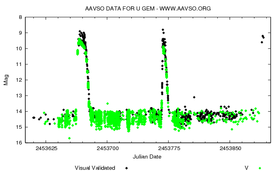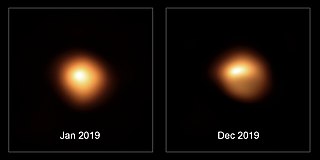
A variable star is a star whose brightness as seen from Earth changes with time. This variation may be caused by a change in emitted light or by something partly blocking the light, so variable stars are classified as either:
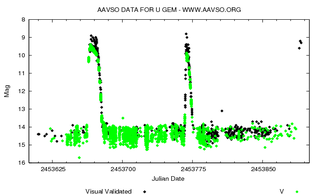
U Geminorum, in the constellation Gemini, is an archetypal example of a dwarf nova. The binary star system consists of a white dwarf closely orbiting a red dwarf. Every few months it undergoes an outburst that greatly increases its brightness. The dwarf nova class of variable stars are often referred to as U Geminorum variables after this star.
An AM Canum Venaticorum star, is a rare type of cataclysmic variable star named after their type star, AM Canum Venaticorum. In these hot blue binary variables, a white dwarf accretes hydrogen-poor matter from a compact companion star.

RX Andromedae is a variable star in the constellation of Andromeda. Although it is classified as a dwarf nova of the Z Camelopardalis (UGZ) type, it has shown low-luminosity periods typical of VY Sculptoris stars. However, for most of the time it varies from an apparent visual magnitude of 15.1 at minimum brightness to a magnitude of 10.2 at maximum brightness, with a period of approximately 13 days.
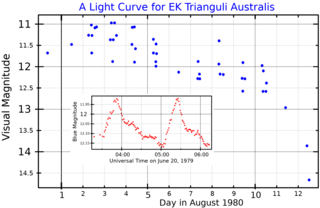
EK Trianguli Australis is a star in the constellation Triangulum Australe. It is a dwarf nova of the SU Ursae Majoris type that officially classified as such in 1980, after the characteristic eruptions of a short eruption and a supereruption were observed in May 1978 and June 1979 respectively. These systems are characterised by frequent eruptions and less frequent supereruptions. The former are smooth, while the latter exhibit short "superhumps" of heightened activity. The distance of the system has been assumed at 180 parsecs from the Solar System, for the donor star. Spectroscopic analysis and calculation gave an estimate of 125 parsecs.

SX Leonis Minoris is a dwarf nova of the SU Ursae Majoris type that was first discovered as a 16th magnitude blue star in 1957, before its identity was confirmed as a dwarf nova in 1994. The system consists of a white dwarf and a donor star which orbit around a common centre of gravity every 97 minutes. The white dwarf sucks matter from the other star via its Roche lobe onto an accretion disc which is heated to between 6000 and 10000 K and periodically erupts every 34 to 64 days, reaching magnitude 13.4 in these outbursts and remaining at magnitude 16.8 when quiet. These outbursts can be split into frequent eruptions and less frequent supereruptions. The former are smooth, while the latter exhibit short "superhumps" of heightened activity and last 2.6% longer.

SS Ursae Minoris is a cataclysmic variable star system in the constellation Ursa Minor. It was discovered visually and by its X-ray emissions separately in 1982 before they were understood to be coming from the same object. It is classified as a SU Ursae Majoris variable subclass of dwarf nova in that it has both 'normal' outbursts of increased brightness as well as even brighter 'superoutbursts'. However, unlike other SU Ursae Majoris stars, the superoutbursts are of longer duration than the regular outbursts.

TV Corvi, also known as Tombaugh's Star, is a dwarf nova of the SU Ursae Majoris type in the constellation Corvus that was first discovered by accident as a mysterious 12th magnitude star on a plate by Clyde Tombaugh while looking for remote planets on May 25, 1932, before its identity was confirmed as a dwarf nova by David Levy in 1990.

In astronomy, a superhump is a periodic brightness variation in a cataclysmic variable star system, with a period within a few percent of the orbital period of the system.

SU Ursae Majoris, or SU UMa, is a close binary star in the northern circumpolar constellation of Ursa Major. It is a periodic cataclysmic variable that varies in magnitude from a peak of 10.8 down to a base of 14.96. The distance to this system, as determined from its annual parallax shift of 4.53 mas, is 719 light-years. It is moving further from the Earth with a heliocentric radial velocity of +27 km/s.
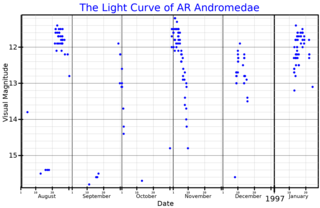
AR Andromedae is a dwarf nova of the SS Cygni type in the constellation Andromeda. Its typical apparent visual magnitude is 17.6, but increases up to 11.0 magnitude during outbursts. The outbursts occur approximately every 23 days.

DX Andromedae is a cataclysmic variable star in the constellation Andromeda. It has a typical apparent visual magnitude of 15.5 during the quiescent phase, but becomes brighter during outbursts recurring with a mean cycle length of 330 days, thus is classified as a dwarf nova of the SS Cygni type.

LL Andromedae is a dwarf nova in the constellation Andromeda, discovered during an outburst in 1979. Its typical apparent visual magnitude is 19.4, but undergoes outbursts events when can reach a peak magnitude of 14.3. Since this magnitude is reached during the most powerful outbursts, while less bright outbursts can occur, it is classified as a SU Ursae Majoris variable.

PX Andromedae is an eclipsing cataclysmic variable star in the constellation Andromeda. It has been classified as a SW Sextantis variable, and its apparent visual magnitude varies between 14.04 and 17.

V455 Andromedae is a dwarf nova in the constellation Andromeda. It has a typical apparent visual magnitude of 16.5, but reached a magnitude of 8.5 during the only observed outburst.

BZ Ursae Majoris is a dwarf nova star system in the northern circumpolar constellation of Ursa Major. It consists of a white dwarf primary in a close orbit with a red dwarf. The latter star is donating mass, which is accumulating in an accretion disk orbiting the white dwarf. The system is located at a distance of approximately 505 light years from the Sun based on parallax measurements.

RZ Leonis Minoris is a cataclysmic variable star system in the northern constellation of Leo Minor. It undergoes frequent outbursts that vary in brightness from an apparent visual magnitude of 14.4 down to 16.8. Based on parallax measurements, this system is located at a distance of approximately 2,160 light years from the Sun.

SW Ursae Majoris is a cataclysmic binary star system in the northern circumpolar constellation of Ursa Major, abbreviated SW UMa. During quiescence it has an apparent visual magnitude of 16.5–17, which is too faint to be visible to the naked eye. Based on parallax measurements, it is located at a distance of approximately 526 light years from the Sun.
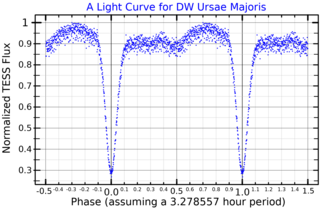
DW Ursae Majoris is an eclipsing binary star system in the northern circumpolar constellation of Ursa Major, abbreviated DW UMa. It is a cataclysmic variable of the SX Sextanis type, consisting of a compact white dwarf that is accreting matter from an orbiting companion star. The brightness of this source ranges from an apparent visual magnitude of 13.6 down to magnitude 18, which is too faint to be viewed with the naked eye. The distance to this system is approximately 1,920 light years based on parallax measurements.

ER Ursae Majoris is a variable star in the northern circumpolar constellation of Ursa Major, abbreviated ER UMa. It is a prototype system for a subclass of SU Ursae Majoris dwarf novae. The system ranges in brightness from a peak apparent visual magnitude of 12.4 down to 15.2, which is too faint to be visible to the naked eye. The distance to this system, based on parallax measurements, is approximately 1,163 light years.

